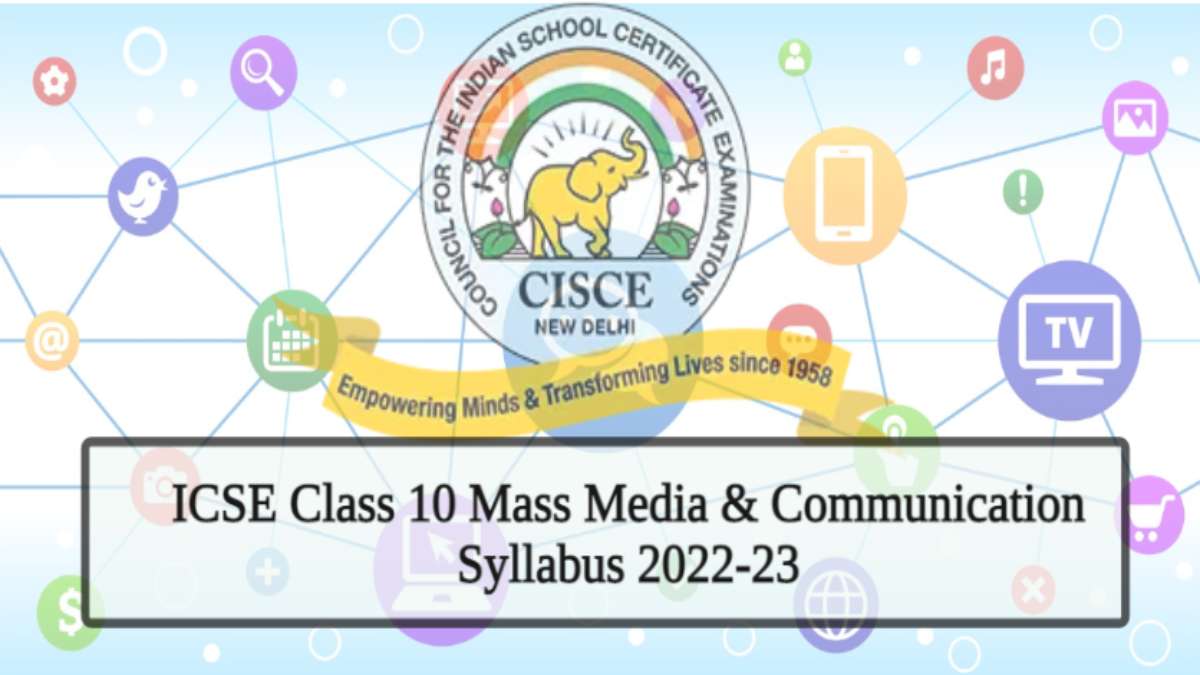ICSE Class 10th Mass Media & Communication: Students appearing for the upcoming ICSE Class 10 Mass Media & Communication Exam should be aware of the updated syllabus of the subject. A subject’s syllabus is important in multiple aspects for students as well as tutors. A board-authorized syllabus helps the students to prepare for their exams according to the set boundaries and not go over the syllabus. The 2022-23 batch of Class 10 Mass Media & Communication students can find the syllabus below which is divided into 5 Units:
|
CLASS X MASS MEDIA & COMMUNICATION (90) Note: The Syllabus for this Subject has not been changed. There will be one written paper of two hours duration carrying 100 marks and an Internal Assessment of 100 marks. |
Theory Syllabus– 100 Marks
1. Communication
(i) Principles of Communication
A brief understanding of the following, with examples: irreversible, multi-purpose, interactive, Transactional, and Punctuated.
(ii) Barriers/Noise in Communication
A brief understanding of the types of barriers in communication, with examples: Physical, Psychological, Semantic, Organizational, and Cultural.
(iii)Overcoming the barriers/noise in communication
Understanding the audience and the context; Selection of the appropriate communication channel; use of appropriate language; formulation of the message according to the specific objectives; message must be coherently structured; ensure proper feedback and feed forward. A brief understanding of the above with examples.
(iv) Effective Communication – 7Cs
A brief understanding of the 7Cs of Communication: Clarity, Conciseness, Concreteness, Correctness, Coherence, Completeness, and Courtesy.
2. Print Media and Design
(i) Anatomy of a Newspaper and Magazine.
A brief understanding of: Page layout, Visual weight, types of pages, order of pages, use of Ads, use of images, white space and lines, eye movement, position of hard and soft news, headings and font sizes.
(ii) Elements of a Newspaper
A brief understanding with examples of: Masthead, Teaser, Headline, Banner, Byline, Lead/intro, Lead photo, and Caption. Imprint line and advertisements.
(iii) Principles of Design
A brief understanding of Balance, Proportion, Sequence, Unity, Repetition and variety and Emphasis, with examples.
(iv) Concepts of Page making
A brief understanding of page weighting, use of space, colour and typography with examples.
3. Photography
(i) Importance of photography in Newspapers and magazines.
Importance of photography in creating a picture of the story, educating, entertaining, drawing attention, and balancing the page.
(ii) Photo Editing
Perspective; composition: the rule of thirds; cropping; colour correction: brightness and contrast; Image file formats: BMP, JPEG, PNG, TIFF A brief understanding of the above with examples.
4. Television
(i) A brief history of Television (globally).
Eras of television broadcasting to be studied briefly:
Black and White: John Baird (creator of television and early contributions), first transmission (America 1928 and BBC transmission), World War II (halt of television production); Cathode ray and mechanical scanning, a first television station (location, name and impact). Colour: First colour television (initial impact), Baird’s improvement (use of scanning disks), Peter Goldmark (introduction of electromechanical system), first colour programs (early program types, impact), compact television (success and impact).
Digital: Switch from analog to digital (initial reception and impact), HDTV, NTSC, and PAL (Brief understanding, resolutions, and distinction).
(ii) Characteristics of Television.
An understanding of television as a medium: audio-visual medium; live medium; mass medium; domestic medium; transitory medium and expensive medium.
(iii)Types of Television.
A brief understanding of different types such
as:
− CRT, Plasma, LCD, LED and OLED,
− SD, HD & UHD
− Smart TV
(iv) Television Broadcasting in India.
Television broadcasting in India from 1959 to present times to be done briefly.
(v) Types of Television Broadcasting
A brief understanding of different types of television broadcasting such as: terrestrial, cable, satellite/DTH, IPTV and online broadcasting.
5. Integrated Marketing Communications- IMC
(i) A brief understanding of IMC; benefits of IMC.
Self-explanatory.
(ii) Direct Marketing.
Definition of direct marketing; Marketing Mix – 4 Ps: a brief understanding of Product, Price, Promotion and Place.
(iii)Internet Marketing.
Definition; Internet as an IMC tool; Interactivity; Advantages and disadvantages of internet marketing.
(iv) Sales Promotion.
Definition; types: consumer-oriented and trade oriented; uses of Sales Promotion.
(v) New ways of Advertising.
Cross promotions, covert advertising, and merchandise.
(vi) Public Relations.
Definition; Role of Public relations: build a brand image, prepare feedback which allows for improvement, generate goodwill, evaluate and monitor media tools, aid in advertising and sales promotion, and crisis management.
(vii) Difference between Public relations and Advertising.
A brief understanding.
Note: Case studies may be used to develop a better understanding of the above concepts.
Download the complete 2023 Mass Media & Communication syllabus for ICSE Class 10 from the link below:
Related topics:
